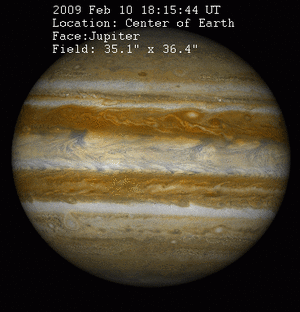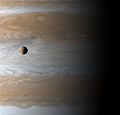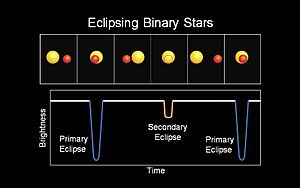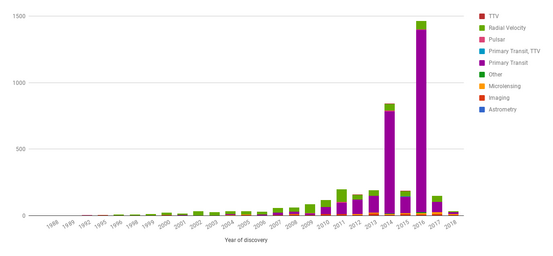Astronomical transit facts for kids
In astronomy, a transit happens when one celestial body passes directly in front of another larger body, as seen by an observer. Imagine a tiny bug crawling across a giant ball. From your view, the bug moves across the ball's surface, covering a small part of it.
The word "transit" is used when the object passing in front looks smaller than the object it's passing in front of. If the object passing in front looks bigger and completely hides the other object, that's called an occultation.
It's quite rare to see a planet transit. This is because the three objects (the observer, the planet, and the star) need to line up almost perfectly straight. When a transit does happen, scientists can learn a lot about the planet and its star.
Contents
Transits in Our Solar System
One common type of transit involves a planet passing between Earth and the Sun. This can only happen with planets that are closer to the Sun than Earth is. These are called inferior planets, like Mercury and Venus. You might have heard of the transit of Mercury or the transit of Venus.
But transits depend on where you are watching from! For example, if you were on Mars, you could see the Earth pass in front of the Sun. Even our Moon can transit the Sun if seen from far away. The STEREO B spacecraft once saw the Moon transit the Sun. From that distance, the Moon looked much smaller than it does from Earth.
The term "transit" also describes a moon moving across its parent planet. For instance, you can sometimes see one of Jupiter's large moons (Io, Europa, Ganymede, or Callisto) pass in front of Jupiter when viewed from Earth.
It's very rare, but sometimes four celestial bodies can line up. One such event happened on June 27, 1586. On that day, Mercury transited the Sun as seen from Venus. At the same time, Mercury also transited the Sun as seen from Saturn, and Venus transited the Sun as seen from Saturn!
Famous Transit Observations
Scientists didn't plan any missions to watch the transit of Earth from Mars on May 11, 1984. The Viking missions had ended a year before. The next chance to see Earth transit the Sun from Mars will be in 2084.
On December 21, 2012, the Cassini–Huygens probe was orbiting Saturn. It observed the planet Venus passing in front of the Sun.
On June 3, 2014, the Mars rover Curiosity watched Mercury transit the Sun. This was the first time a planetary transit was seen from a celestial body other than Earth!
Planets Passing in Front of Each Other
Sometimes, one planet can pass in front of another planet. If the planet closer to you looks smaller than the planet farther away, it's called a mutual planetary transit.
-
Mercury transiting the Sun, seen from the Curiosity rover on Mars (June 3, 2014).
Transits Beyond Our Solar System
Scientists use the transit method to find exoplanets, which are planets outside our Solar System. When an exoplanet passes in front of its host star, it blocks some of the star's light. If the planet transits between the star and our telescopes, we can measure this dip in light. This measurement creates a "light curve" graph.
A light curve can tell us many things about the planet and its star, like their size. Scientists need to see multiple transits to figure out these details. These transits usually happen at regular times. Sometimes, if there are many planets orbiting the same star, their gravity can cause slight changes in when the transits happen. This is called transit-timing variation (TTV).
It's not very likely to see a transit from Earth for any specific star system. This is because the planet's orbit has to be perfectly lined up with our view. However, by watching many stars, scientists have found many exoplanets this way. Large planets called Hot Jupiters are easier to spot because they block more light and orbit very close to their stars. To find Earth-sized planets, scientists often look at small, dim stars called red dwarfs. Even with the low chance of seeing a transit, this method has been very successful for finding exoplanets.
The transit of celestial objects is one of the main ways we study exoplanetary systems today. Transit photometry is the most common way to discover exoplanets. When an exoplanet moves in front of its star, the star's brightness dims. Larger planets cause a bigger, more noticeable dip in brightness. Scientists often use other methods to confirm that what they found is indeed a planet.
As of July 2025, 2782 planets have been confirmed using light curves from the Kepler mission.
Transit Contacts
During a transit, there are four special moments called "contacts." These are when the edge of the smaller body touches the edge of the larger body at a single point. In the past, measuring these exact times helped astronomers figure out the positions of celestial bodies very accurately. The contacts happen in this order:
- First contact: The smaller body is completely outside the larger body and just begins to move inward.
- Second contact: The smaller body is now completely inside the larger body and continues to move further inward.
- Third contact: The smaller body is still completely inside the larger body but starts to move outward.
- Fourth contact: The smaller body is now completely outside the larger body and continues to move away.
There's also a fifth important point called "greatest transit." This is when the centers of the two bodies are closest to each other, which is halfway through the transit.
Space Missions for Transits
Because the transit method is good for scanning large areas of the sky, it has been the most popular and successful way to find exoplanets in recent years. Many projects use this method. Some have finished, some are still working, and some are being planned. The most successful projects include HATNet, KELT, Kepler, and WASP. Newer missions include TESS and HATPI. You can find more on the List of Exoplanet Search Projects.
HATNet
The HATNet Project uses telescopes in the northern hemisphere at the Fred Lawrence Whipple Observatory in Arizona and the Mauna Kea Observatories in Hawaii. It also has southern telescopes in Africa, Australia, and South America, under the HATSouth branch. These telescopes are small but can look at a wide area of the sky. This allows them to search a large region for possible transiting planets. Having many telescopes spread around the world means they can observe the sky 24/7. This helps them catch transits that happen very quickly.
A new part of the project, HATPI, is being built. It will survey most of the night sky from its location in Chile.
KELT
KELT is a ground-based telescope mission. It looks for transiting planets around stars that are not too bright or too dim. It started working in October 2004 at Winer Observatory. A southern companion telescope was added in 2009. KELT North observes a wide strip of sky that passes overhead from North America. KELT South observes specific areas. Both telescopes can find transit events where a star's brightness drops by as little as 1%. This helps them find planetary systems similar to our own.
Kepler / K2
The Kepler space telescope worked on the Kepler mission from March 7, 2009, to May 11, 2013. During this time, it watched one part of the sky to find transiting planets. This area was about 115 square degrees around the Cygnus, Lyra, and Draco constellations. After that, the satellite kept working until November 15, 2018. It changed its view along the ecliptic to a new area about every 75 days because of a problem with its reaction wheels.
TESS
The TESS was launched on April 18, 2018. It is designed to survey most of the sky. It does this by observing strips of the sky for 27 days each. Each area it surveys is 27 by 90 degrees. Because of how these sections are positioned, the area near TESS's rotational axis is surveyed for up to one year. This allows TESS to find planetary systems with longer orbital periods.
See also
- Eclipse
- Kepler Mission
- Occultation
- Syzygy (astronomy)
- Transit of asteroids
- Transit of Deimos from Mars
- Transit of Phobos from Mars
- Transit of Vulcan
- Transit of Mercury from Mars
- Transit of Earth from Mars








